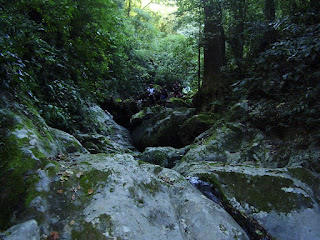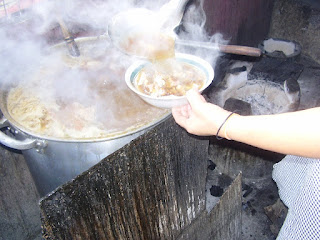
I have always been looking forward for a chance to experience mystical Mount Banahaw. My longing was finally came into a reality, when i had the chance to come along through the journey of my friends to the Holy Mountain. - Mount Banahaw, an experience to remember. "It's been a long day short journey" of my life.
Typical Four-Day Schedule
DAY 1
0700 Breakfast. Check equipment and supplies.
0800 Leave Manila for San Pablo, Laguna via public bus or hired vehicle.
1000 Arrive at San Pablo. Proceed to Santa Lucia by public jeepney.
1030 In Santa Lucia, contact National Parks Station for a guide.
1100 Hike to Kinabuhayan.
1230 Take lunch at Kinabuhayan.
1330 Begin climb.
1400 Reach first waterfall: Kristalino Falls.
1530 Arrive at second waterfall. Rest and find suitable spot to set up camp. Enjoy the scenery and the cool, refreshing water.
1700 Early dinner with the soothing sounds of the falls in the background.
DAY 2
0700 Breakfast. Pack up and remove all debris from campsite prior to continuation of ascent. 0800 Climb up vertical wall. Find way over narrow ridge, under which is a small waterfall referred to as Salamin Bubog (Glass Mirror).
0900 Reach detour and backtrack slightly to locate trail.
0920 Traverse a treacherous, slippery gully to a natural cave known as Kuweba ng Dios Ama (Cave of God the Father).
1030 In the cave, take a brief rest and snacks.
1100 Climb rock formation with 45-degree gradient. There are hardly any handholds due to the absence of any plants or trees. Climbers can rely solely on cracks along the surface. At the base is a deep gully. Good luck!
1130 Arrive at top marked with tall grass and trees. Encounter diverging paths. Always follow one going to the right.
1200 Lunch along the way.
1300 Resume climb.
1430 Reach Pintong Lihim (Secret Door). Proceed to the summit. Come across bent twisted trees. Residents of the area call this particular spot Niluhuran (place where they knelt).
1900 Arrive at the peak: Santong Durungawan (Holy Window). Establish camp and take dinner.
DAY 3
0700 Breakfast. Break camp. Take photos if weather permits.
0800 Start descent.
1300 Reach Tatlong Tangke (Three Tanks). This term refers to a series of waterfalls. Have lunch.
1400 Resume hike down. Pass through a gully and over the kaingin (slash-and-burn farming) trail.
1600 Cross over rocky trail which leads to the "backyard" of the town of Kinabuhayan.
1630 At Kinabuhayan, inform Barrio Captain about arrival.
Find suitable place to stay overnight. Mingle with townsfolk to get first-hand experience about life and customs in a typical Filipino barrio.
DAY 4
0700 Breakfast.
0800 Return to Manila.
Special Considerations
Always contact local weather station for the latest conditions within the vicinity of the climb.
It is possible to attempt the climb anytime of the year in absence of tropical depressions or if advised otherwise by the local weather bureau.
Guard against leeches especially during the rainy season. Secure cuffs of long-sleeved t-shirts and pants. Tweezers and lighted cigarettes are useful for removing leeches. As a preventive measure, ordinary soap may be rubbed on pants and shoes to ward off leeches
1 day 1 night schedule (into the summit; holy window, unang dungaw ) - a long day short journey
Always contact local weather station for the latest conditions within the vicinity of the climb.
It is possible to attempt the climb anytime of the year in absence of tropical depressions or if advised otherwise by the local weather bureau.
Guard against leeches especially during the rainy season. Secure cuffs of long-sleeved t-shirts and pants. Tweezers and lighted cigarettes are useful for removing leeches. As a preventive measure, ordinary soap may be rubbed on pants and shoes to ward off leeches
1 day 1 night schedule (into the summit; holy window, unang dungaw ) - a long day short journey
We were at the foothills of Mount Banahaw around 7am after we finish a bowl of Special Mami "pares", we hurried ourselves to nearby parking slots, which i learn is not a parking area, but from a friends' house.
After 10 hours of trekking (Jojo Gimena, Ian , Jun Albay got there earlier, about 2PM ) I finally reached the summit.
Santong Durungawan : we camped for a night at the first peak of the holy mountain, we enjoy the food we bring along.
Before we go to sleep we had shots of Fundador, for us to make a goodnight sleep.
 The morning breeze wake me up and voice of my friends, laughing with their experience during the climbed.
The morning breeze wake me up and voice of my friends, laughing with their experience during the climbed.About 8 AM, we decided to go down.Another long journey back home. But we made it to the foothilss before 1PM.
We take a bath at the nearby river, just few steps from Bakas (Christ’s foot print), where we take get waters for take out ")
Close by was the “Cueva de Jusgado [Cave of Judgment].” It had a small opening just enough for one person to back into. There was an anecdote that pilgrims who are sinners cannot enter this cave no matter how much they try.We leave everything behind so as not to be carrying much once we are inside." As we entered, we brought flashlight, simply because it was totally dark inside.
 When it was my turn to enter, my hearts beats faster. It's like im going to have an asthma attack, I can't breath. But I decided to continue. And ascend myself into the holes. It was difficult to find any foothold for my feet to help me move forward from my awkward position.
When it was my turn to enter, my hearts beats faster. It's like im going to have an asthma attack, I can't breath. But I decided to continue. And ascend myself into the holes. It was difficult to find any foothold for my feet to help me move forward from my awkward position. Entering the cave was like being born, as there was no way I could return to the entrance. I thought that was the only problem. I learned too late that I was inside a long, dark, narrow cave (tunnel) about 20 to 30 meters in length just big enough for my body to make slight movements. Some portions were slippery and surrounded by sharp, protruding stones.
I had to slither and contort my body like a snake to come out unhurt. There is no point of turning back as it is easily to continue and make it to the end, as it was doubly difficult to return.
 In moments like this, faith in oneself and, most of all, faith in God, plus a little resourcefulness can help keep one's head.
In moments like this, faith in oneself and, most of all, faith in God, plus a little resourcefulness can help keep one's head. But finally after the terribly difficult obstacle course, the sense of achievement was simply exhilarating.
The Cueva de Jusgado was very symbolic of life, for in life there are many obstacles and ignoring them won't solve the problem.
One must think be confident, have faith in oneself and in God, be resourceful and continue moving forward to be triumphant.

















 Daday" ang taong bundok, hehehehe. i know this guy from the basketball court in our hometown, Taytay,Rizal. Daday served as my guide/sherpa. Sherpa? hmmmm well this guy trained along side with the pinoy who climbed Mt. Everest, here in Mt. Banahaw, those people were trained here in Mt. Banahaw and got their energy and stamina from the Mountains of Banahaw. The Mountain of Banahaw served as the training ground of mountaineers. Well those people who have known from around the world being the First Filipino climbed the Mt. Everest mostly were the product of the Holy Mountain.
Daday" ang taong bundok, hehehehe. i know this guy from the basketball court in our hometown, Taytay,Rizal. Daday served as my guide/sherpa. Sherpa? hmmmm well this guy trained along side with the pinoy who climbed Mt. Everest, here in Mt. Banahaw, those people were trained here in Mt. Banahaw and got their energy and stamina from the Mountains of Banahaw. The Mountain of Banahaw served as the training ground of mountaineers. Well those people who have known from around the world being the First Filipino climbed the Mt. Everest mostly were the product of the Holy Mountain.